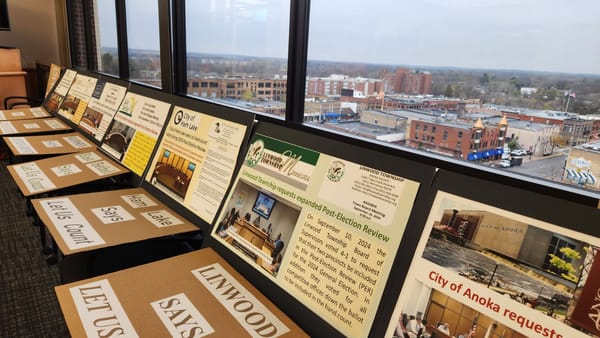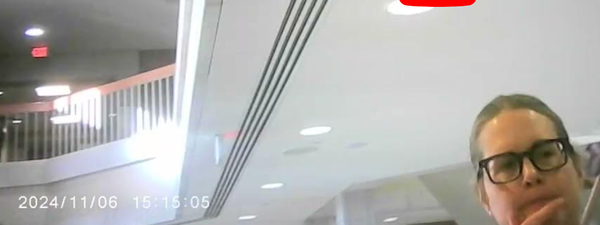Electronic Poll Pads Will Be Sent Back to County
There are a number of counties (such as nearby Isanti County) and cities within those counties that already and have always used paper poll books, but Oak Grove could be the first to change its mind after initially deciding to use the modified iPads from KNOWiNK, which are internet-connected...

City Councils and Town Boards continue to seek local solutions in wake of county and state level resistance to local control, monitoring, and managing of elections. With electronic tabulators mandated by the 93rd Minnesota Legislature and election codes amended to have election judges immediately seal ballots after the closing of polls (to prevent hand counting), councils and boards have limited options remaining.
But, is it too much to ask that it be proven that voters' choices add up at the end of an election?
Tonight, a brief update from Oak Grove (Anoka County) and Inver Grove Heights (Dakota County).
Oak Grove Stands Firm
Tonight the Oak Grove City Council (Anoka County) after much discussion stood firm in its previous decision to not use electronic poll pads and will be sending them back to the county tomorrow. It's quite clear under Minn Stat §201.225 that the electronic "rosters" are optional (video explanations here).
However it appears that the Anoka Elections Manager, Tom Hunt, believes the choice is not up to the cities, as evidenced by a comment in the Anoka County Union Herald last week. It is this writer's opinion that no one will be able to generate any tangible, rational, or legal reasons to overturn Oak Grove's decision. The city will save money, avoid the cyber risk (and possible hidden feature sets of KNOWiNK poll pads), and is well in their authority under Minn Stat §201.225.

There are a number of counties (such as nearby Isanti County) and cities within those counties that already and have always used paper poll books, but Oak Grove could be the first to change its mind after initially deciding to use the modified iPads from KNOWiNK, which are internet-connected, can access data from outside the precinct in certain conditions, and were previously hacked into during a demo by the 2016 St. Bonifacius Mayor, Rick Weible, who then declined the contract, the only municipality to say No in Hennepin County, where the electronic poll pad rollout began in Minnesota.
Election researcher Erin Clements (New Mexico) has suggested that a larger part of the potential for cheating has migrated to the electronic poll pads, which makes sense given that voter data is available in real-time and the devices have been shown to be capable of monitoring and modifying that data. One could speculate how the Attorney General in 2020 was able to tweet about not having enough votes—one theory is that the electronic poll pads allowed that information to be known by the AG. When it is considered that many electronic tabulators, such as the commonly used ES&S DS200, now have embedded Verizon modems—as proven in several public accuracy tests prior to the 2024 primary election—the networked nature of these systems comes into clearer view.
The Oak Grove meeting may become available in a future posting.
Inver Grove Heights Receives Additional Information about Post Election Reviews
Meanwhile, in Inver Grove Heights, as a follow up to a previous presentation in September, three people spoke during public comment about the option expanding their hand count by including one or more precincts in the Dakota County post election review.
Oak Grove was the first Minnesota city back in April 2024 to initiate this plan which is in line with Minnesota Statute 206.89—if the County Canvassing Board, which meets at 2pm on November 13 in the Anoka County Government Center decides to accept their offer. State statute calls for a minimum of 3% of precincts to be hand counted, but there is no maximum. Gary from the Office of the Secretary of State has confirmed that under Rule 8235, hand counting is the method of choice to decide close races. It is also trusted during these post election review audits. Time will tell if the Inver Grove Heights City Council decides to move ahead with also seeking to include one or more of their precincts in the post election review.
So far, 7 total municipalities in Anoka County want to go this route as well.
There is precedent for the above. Just look at Big Lake, in Sherburne County, where the City Council worked with the County Auditor to arrange that at least one of their precincts be included in the event that none of their precincts were chosen by lot during the County Canvass. That was in 2022.
(The County Canvass is where the County Canvassing Board first certifies the county election and then draws the precincts for the audit—it is not clear how the election can be certified before the audit, especially when in at least one pivotal election, 2020, at the statewide level there was a 700,000 vote gap between absentee ballots reported and those showing up in the Secretary of State's master data set known as the Statewide Voter Registration System.)
The Inver Grove Heights public comment may become available in a future posting.
Post Election Reviews as a Last Line of Defense
During tonight's Inver Grove Heights public comment, one key certificate, from the Dakota County Post Election Review of 2020, which was emailed by former Dakota County Elections Manager Andy Lokken to Attorney Jane Volz, showed more than 800 absentee ballots missing.
The explanation later given by Lokken was that although the absentee ballots weren't there, they were subsequently acquired and counted/tallied accurately. This, if indeed it was done, was not done publicly, and is completely off process and out of line with Minnesota law (see Minn Stat §206.89 Subd. 4 and Subd. 5). Neither the Office of the Secretary of State nor the Attorney General's Office appear to have looked deeply into the matter, and so for the last 4 years this information has effectively been censored.

This same document was also put on the public record in the Petition to Stop the Certification of Minnesota back in 2020, given that the Dakota County post election review did not meet the standards set out in Minnesota Statute §206.89 Subd. 4, which should have triggered additional reviews according to §206.89 Subd. 5. This petition was effectively thrown out by Chief Justice Gildea, probably to avoid Minnesota missing the December 8, 2020 safe harbor deadline, without, in this writer's opinion, reviewing the case on its merits.




